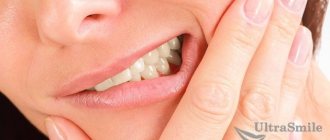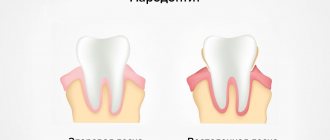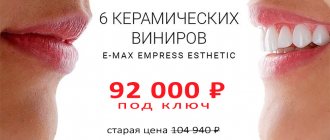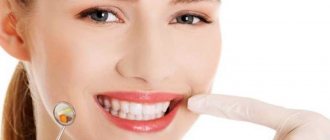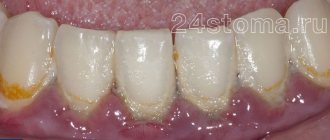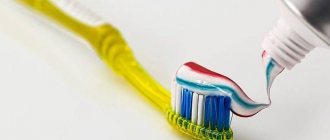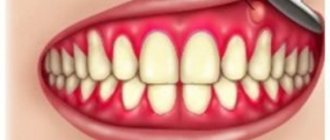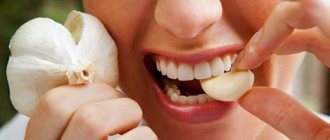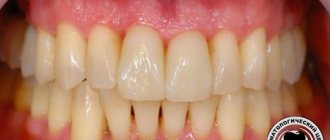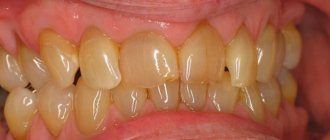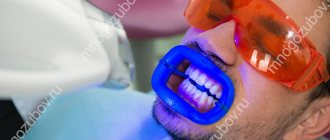Why does periodontal disease occur?
Ordinary people not connected with medicine often confuse the concepts of “periodontal disease” and “periodontitis”. The first is rare, no more than 8% of all people, mostly elderly. But even among young people, sudden and fleeting development of periodontal disease occurs.
The most commonly cited reasons for this problem are:
- Insufficient oral care. In particular, poor brushing of teeth, resulting in the formation of plaque.
- Unstable hormonal levels: pregnancy, puberty, menopause.
- Weak immunity due to a serious illness.
- The presence of diseases that primarily affect the immune system: cancer, HIV, diabetes.
- Bad habits. It has long been known that smoking destroys gum tissue, which means it contributes to the development of periodontal disease.
- Wrong lifestyle. Insufficient consumption of fresh fruits and vegetables weakens the immune system. Internal organs do not receive enough vitamins and minerals and begin to take them away from the bone tissue of the teeth.
- Long-term use of certain medications that reduce the normal flow of saliva. It provides gums with protection from external factors, such as eating rough food.
Injections into the gums for periodontal disease
In addition to drug treatment, injections for periodontal disease are also used. These are injections of aloe extract, which is an effective biogenic stimulant. Typically, the course of treatment consists of 20 - 25 injections with a break per day. What injections for periodontal disease are prescribed if the disease has become severe? In the presence of an inflammatory process in the later stages of the disease, dental periodontal disease can be treated with injections with synthetic tissue regeneration stimulators according to the same scheme.
How to recognize periodontal disease
The signs of this dental disease are unclear and blurred. The patient is most often concerned about:
- exposure of the necks of the teeth;
- presence of tartar;
- burning gums;
- discomfort when eating.
Periodontal disease is not accompanied by pain, light pink gums are not visually inflamed, so the patient often postpones a visit to the dentist. In addition, the above symptoms of periodontal disease appear inconsistently.
Periodontal disease and osteoporosis
While one of the signs of osteoporosis, periodontal disease is not usually the first symptom. In metabolic skeletal disease, bone mass decreases uniformly throughout the body. This disrupts its density in the jaw and facial area, which subsequently causes a decrease in the volume of the gums.
With careful attention to the health of the oral cavity, you may notice that the teeth begin to turn yellow in the cervical area. And in this case, you need to urgently contact a dentist, and then an endocrinologist, since the destructive process in bone tissue has already begun.
But most often, the first symptom of osteoporosis is a “spontaneous” fracture in the femur or radius, which occurs without serious injury. Just with an awkward movement, an accidental fall, even coughing and sneezing. The disease may be accompanied by pain in the spine and muscle weakness, but usually it is asymptomatic.
“Bone tissue is in a state of constant change and renewal,” explains Lesnikova. “Two opposite processes take place in it at the same time. This is the formation of bone and its destruction - bone resorption. The quality, strength, and mineral density of bone depend on their balance and ratio. Disruption of the interaction of these processes leads to the development of osteoporosis.”
Stages of disease development
There are 3 stages of periodontal disease:
- Easy.
The patient has no complaints; very rarely there is a reaction to cold or hot food. The presence of periodontal disease can be determined during a dental examination. The mild stage of the disease is best treated.
- Average.
The roots of the teeth are exposed by an average of 4-6 mm. The patient begins to experience a burning sensation in the mouth, and there is an acute reaction to eating hot, cold or sour foods.
- Heavy.
The roots of the teeth are exposed by 8-10 mm. Chewing food causes severe pain.
Periodontal disease at home: how to treat?
Treatment of periodontal disease at home should not be the only method of solving the problem. This is more of an additional help, but the main one takes place in the dentist’s office and only on his recommendations.
Adviсe:
- Rinse your mouth as often as possible. Pour 20 drops of propolis solution into a glass of warm water. It disinfects and soothes gums. Linden, St. John's wort and oak bark have a similar property.
- Rub your gums. Prepare a mixture of 25 g honey and 5 g salt. Stir until dissolved. Apply to a clean bandage and rub your gums with this product for 5-10 minutes.
- Brush your teeth well twice a day. Do not forget to use dental floss after eating and rinse your mouth with clean water.
- Eat sauerkraut as often as possible and rinse your mouth with its juice.
Treatment of gums with periodontal disease, first of all, should be aimed at strengthening bone tissue. Therefore, the first stage in the fight against the disease is changing your diet. The following should be completely excluded from the menu:
- chocolate and candies;
- carbonated drinks;
- cookies, waffles, gingerbread.
These are solid carbohydrates that create a favorable environment for the proliferation of bacteria.
Eat lean boiled meat, fatty fish, cottage cheese and any other fermented milk products as often as possible. They contain a lot of protein, which will help restore bone tissue. Don't forget about fresh vegetables, fruits, berries and herbs.
Change your toothbrush. A model with soft, comfortable bristles is suitable. It will not cause mechanical trauma to the gums while brushing your teeth. The paste should be plant-based.
Recipes for strengthening bone tissue:
- Take 20 g of myrrh, add 15 g of chopped mint and raspberry leaves. Dilute a mixture of 80 g of wine alcohol and 25 g of vinegar. Stir and pour into a glass jar. Leave for 3 days in a dark place. Afterwards, rinse your mouth twice a day.
- Pour 50 g of chopped sage into 100 g of boiling water. Leave covered for an hour. Rinse your mouth thoroughly.
- Chop fresh plantain leaves and crush well. Soak a clean cotton swab with the resulting juice and wipe the gums with it.
- Pour 30 g of dried calamus into 0.5 liters of vodka. Leave for a week in a dark place, then strain. Add 3 tbsp. l. mixture into a glass of water and rinse your mouth for 3-6 minutes.
- 6 tbsp. l. Mix crushed pine needles with a liter of boiling water. Bring to a boil, strain and set aside. Rinse your mouth morning and evening.
The next stage is the removal of dental plaque above and below the gums.
The main cause of the inflammatory process during periodontal disease is the presence of a large amount of plaque. Its formation is a consequence of insufficient oral care. Therefore, it is impossible to achieve effective treatment unless the root cause is removed. The optimal way to treat tartar and plaque in modern dentistry is the use of ultrasound.
The next stage of eliminating periodontal disease is therapy aimed at relieving inflammation. As a rule, it lasts about 10 days.
The course consists of rinsing the mouth for an antiseptic effect.
Algorithm:
- After breakfast, brush your teeth thoroughly for 3-6 minutes.
- Rinse mouth with chlorexidine (0.05%).
- Dry the gums using a clean cotton swab.
- Apply a special gel to the gums.
- Do not eat for at least 2 hours, drink only clean water.
Such step-by-step treatment is prescribed for mild cases of the disease. If the development of periodontal disease has reached its climax, you will need to take antibiotics (7-10 days). The doctor may prescribe tablets or intramuscular injections.
Non-surgical adjuvant therapy for the treatment of periodontal diseases
Periodontal disease is an umbrella term used to describe an infectious inflammatory process that can affect one structural element or a complex of periodontal elements. The structures that support the tooth are alveolar bone, periodontal ligament and root cementum. Periodontal diseases are mainly provoked by the action of dental plaque or microbial biofilm, which is a heterogeneous structure of pathogenic microorganisms. More than 500 species of microorganisms are considered potential etiological agents that provoke damage to periodontal tissues. In addition to them, viruses and fungi also play an important role in the pathogenetic process. As the disease occurs and progresses, pathogenic microorganisms colonize the gum area surrounding the tooth, and as a result of their impact on the tissue, a periodontal pocket begins to form. Up to 109 species of bacteria can be found in deep periodontal pockets, but despite the potential of many pathogens that are associated with periodontal disease, only a small number are associated with active disease.
Socransky et al divided pathogens involved in disease progression into two main groups: the “red” and “orange” complexes. The red complex includes the following Gram-negative anaerobic bacteria: Porphyromonas gingivalis, Treponema denticola and Tanneralla forsythia, while the orange complex consists of Prevotella nigrescens, Peptostreptococcus micros, Campylobacter rectus, Centruroides gracilis, Campylobacter showae, Eubacterium nodatum and Streptococcus constellatus. In addition, Aggregatibacter actinomycetemcomitans and Eikenella corrodens are closely associated with periodontal diseases. As a result of numerous studies, it has been established that in order to achieve a successful treatment result, one aspect of therapy must be aimed specifically at neutralizing these bacteria, the activity of which is directly related to the course of the disease.
Antibiotics
Systemic antibiotic therapy should be considered as an acceptable treatment option for patients with periodontitis. This approach is relevant for patients who are resistant to conventional disease therapy or who have the following health problems: the presence of an abscess, a compromised or weakened immune state, uncontrolled diabetes mellitus, the presence of signs and symptoms of systemic lesions, fever and lymphadenopathy. The choice of the most appropriate systemic antibiotic should be based on the results of culturing microorganisms and testing their sensitivity to a particular drug. Thus, it is possible to find out, firstly, what microorganisms are present in the affected area, and, secondly, to select the most effective and active agent. But it should be remembered that systemic antibiotic therapy should not be the only method of treatment, but only represent a segment of an integrated approach to examination, diagnosis and development of adequate systemic therapy. Antibiotic therapy, like any other treatment method, has its advantages and disadvantages. Since taking these drugs is a fairly well-known method of treatment, patients, as a rule, understand the main key points of this treatment, and without any problems agree to the proposed algorithm for the course of medications. But at the same time, patients can often confuse the official main names of medications, forget the dose, time, or even the very fact of taking them, thereby disrupting the effect of their action. Systemic antibiotics may cause side effects and gastrointestinal disturbances in the form of diarrhea or abdominal cramps. Other possible negative effects of drugs are associated with allergic reactions and the emergence of bacterial resistance to antibiotics during prolonged and uncontrolled use. Bacterial resistance is a major concern in medicine because it creates a number of other scientific and clinical dilemmas regarding the therapeutic trade-off between the risk of treatment and the potential benefit of antibiotics.
Systemic antibiotics reach periodontal tissues by extravasation from the blood serum, after which they pass through the junctional epithelium and lining of the gingival pocket to enter the gingival sulcus area. The effective concentration of the antibiotic when it reaches the gingival sulcus during a course of treatment differs from that in any other tissue system or organ with signs of infection, which is associated with the specific structure of the periodontium. There are a number of well-tested antibiotic regimens for the treatment of periodontal diseases, which are usually used in combination with mechanical removal of supra- and subgingival deposits and bacterial plaque. This approach, combined with effective home oral hygiene, is aimed at reducing the bacterial load in the area of the gum tissue above and below the marginal border. Some physicians commonly prescribe antibiotic regimens for the treatment and management of periodontal disease based on amoxicillin (375 mg) and metronidazole (500 mg) taken 3 times a day for 7 days in combination with oral scaling and complete root planing for the first time. 48 hours. This approach helps to achieve a reduction in pocket depth and reduce bleeding, which was found when comparing treatment results in the study and control groups. An alternative treatment regimen is to take azithromycin (500 mg) for 3 days prior to scaling and root planing to reduce red complex bacteria and reduce gingival scores. In the absence of the ability to culture bacteria and determine their sensitivity to antibiotics, you can use the empirical principle of prescribing drugs for the treatment of periodontitis. Evidence-based treatment options include a combination of amoxicillin and metronidazole (250 mg - 500 mg each) taken 3 times a day for 8 days, or a combination of metronidazole and ciprofloxacin (500 mg) for 8 days, 2 times a day.
Topical antibiotic therapy is an alternative adjuvant treatment option that can also be used during the treatment of periodontal lesions. The essence of the procedure is to deliver the antibiotic directly to the periodontal pocket - that is, directly to the site of colonization of pathogenic bacteria, while the concentration of the antibiotic in the affected area increases markedly compared to systemic administration. Another advantage is the absence of potential gastrointestinal disorders and allergic reactions. The first antibiotic used for topical treatment was Actisite (periodontal tetracycline). It consisted of non-resorbable, tetracycline-impregnated fibers that were placed directly into the periodontal pocket and remained there for 10 days until the next visit to the dentist. Over time, drugs and methods of their delivery to the area of periodontal lesions have been improved. Thus, Atridox (Denmat) was developed, which is the first resorbable topical antibiotic consisting of a gel form of doxycycline. This drug is injected into the pocket using a syringe, and upon contact with saliva, it hardens, acquiring a waxy consistency. Thus, the antibiotic can be released from the solidified phase within 21 days. Arestin (Orapharma) is also a topical absorbable antibacterial that consists of minocycline granules in powder form. It is supplied in the form of ampoules charged into a syringe. The powder is injected directly into the periodontal pocket, the high level of its therapeutic effect continues for 14 days, and the drug itself remains in the pocket for 28 days. Studies have proven that the use of topical antibiotics together with the procedure of complete removal of tartar and root surface cleaning allows to achieve clinically effective results: a decrease in the depth of the pockets and partial restoration of the damaged biological attachment are observed.
Antimicrobial mouth rinses
Antimicrobial rinses are well-known and acceptable procedures that effectively complement the comprehensive treatment of gum tissue inflammation. Examples of their justified use are situations where the patient is unable to provide optimal oral care using conventional hygiene products at home, for example, in the postoperative period. To choose the right mouth rinse that will effectively cope with gum inflammation and at the same time prevent plaque, you need to find out whether it has a Certificate of Approval from the American Dental Association. If yes, then this product has gone through a series of clinical, biological and laboratory tests that have proven its anti-inflammatory and antibacterial effectiveness. However, it should be understood that this assessment is advisory, but not prescriptive regarding the drug. The only rinses available on the market with the appropriate rating of the Association are representatives with phenolic components, such as Listerine and other similar versions. Chlorhexidine gluconate (0.12%) is also considered the gold standard among antimicrobial rinses, which is available only by prescription in the United States and is known under the commercial names Peridex and PerioGuard (Colgate-Palmolive). Chlorhexidine is the most effective antimicrobial rinse, reducing bacteria and providing effective treatment for gingivitis. The drug is more effective against gram-positive bacteria and yeast, and less effective against gram-negative pathogens. It is usually prescribed postoperatively to reduce the bacterial load during the healing period. Chlorhexidine has a high substance content, which ensures its prolonged action. Some side effects associated with the use of chlorhexidine include potential staining of the teeth and dorsum of the tongue; change in taste perception; the risk of possible formation of supragingival stone, the formation of signs of mucositis and desquamation of the epithelium. Other antimicrobial rinses available to the general public, but less often recommended by specialists, are quaternary ammonium derivatives such as Cepacol (Reckitt Benckiser). Sanguinarine-based products, like Viadent, are no longer widely available on the market. Oxygenate-based products, such as hydrogen peroxide, are recommended to be used more often in paste form. They have anti-inflammatory properties, which reduce signs of bleeding. The latter is an important critical indicator for assessing periodontal inflammation. However, these representatives have only a small effect on the level of bacterial contamination, and recently opinions have increasingly been expressed about their possible carcinogenic potential. Triclosan is another antimicrobial agent available in the form of toothpastes and rinses. However, according to research, it also shows minimal effects on the microbial flora of the oral cavity, and the safety of its use is still in question.
Anti-inflammatory agents
We must remember that periodontal diseases are infectious in nature, and inflammatory phenomena are the body's immune response to microbial contamination. In inflamed tissues, the process of proliferation of pathogenic bacteria occurs faster, which leads to the progression of pathological and destructive effects of the inflammatory process, through the activation of cells of the body's immune system (macrophages and their precursors, monocytes, lymphocytes, and polymorphonuclear leukocytes, such as neutrophils). Components of the microbial structure, such as lipopolysaccharide, which is found in the cell walls of gram-negative anaerobic microorganisms, activate macrophages to produce and secrete proinflammatory cytokines such as interleukin-1 (IL-1) and tumor necrosis factor-alpha (TNF-alpha). Interleukin-1 stimulates bone resorption and also promotes the release of PGE2 by fibroblast cells, which are the main and most abundant types of connective tissue cells. Fibroblasts synthesize collagen, the main structural protein of connective tissue, which is also the main component of gum and bone fibers. These cells and inflammatory response cells (neutrophils and macrophages) synthesize matrix metalloproteinases (MMPs), which are enzymes or proteins involved in a number of biological reactions. For example, MMP-1 and MMP-8 are enzymes that are involved in the degradation of collagen, which significantly weakens the periodontal structure. Activation of the immune system is inherently a protective reaction of the body - a response to bacterial invasion, however, during the mechanism of implementation of the immune response, tissues of the host organism itself are destroyed. This phenomenon is associated with the release of cytokines, pro-inflammatory mediators and MMPs, since these agents act not only locally on periodontal tissue, but when entering the bloodstream they can also cause undesirable systemic effects.
MMPs are a group of proteolytic enzymes found in periodontal tissues, which contain collagenase and gelatinase. The function of these enzymes is to remodel the extracellular matrix. Since doxycycline was found by researchers to have anticollagenlytic properties, they proposed its use as a modulatory agent for the treatment of periodontitis. Subantimicrobial doses of doxycycline (20 mg twice daily) are effective in inhibiting collagenase activity while having no effect on antimicrobial resistance when used in combination with complete scaling and root planing. This approach provides the maximum effect for restoring biological tissue attachment and reducing the depth of periodontal pockets.
Oral medications
Nonsteroidal anti-inflammatory drugs (NSAIDs) have also been studied as inhibitors of the host response in the treatment of periodontal disease. Their mechanism of action is to prevent the production of prostaglandins. Prostaglandin E2 (PGE2) is directly associated with the processes of inflammation and bone resorption, which is confirmed by its verification in affected periodontal areas. In the course of studying various NSAIDs (flurbiprofen, ibuprofen, ketorolac, naproxen, aspirin), which were administered systemically or locally, it was found that when they were combined with the procedure for complete removal of plaque and root surface cleaning, it was possible to maintain the existing height of the alveolar ridge, preventing it resorption. Bisphosphonates are a class of drugs that inhibit alveolar bone resorption that have also been used as host-modulating agents in the treatment of periodontal disease. Studies have shown that bisphosphonates, when used in conjunction with full mouth cleaning, reduce periodontal pocket depths and levels of bleeding during probing, as well as improve restoration of biological attachment and maintain ridge height. However, despite the potential benefits of bisphosphonates, studies have shown that long-term use and high doses of the drugs initiate osteonecrosis of the jaw. Obviously, for reasoned conclusions, it is necessary to conduct further more detailed studies that will help determine the ratio of the potential benefits of drugs and the relative risk of complications in the treatment of periodontitis.
Host modulation therapy
Local application of host-modulating agents, such as enamel matrix proteins, bone morphogenetic proteins and platelet-derived growth factors, can be quite effective in the complex treatment of periodontitis. Enamel matrix proteins are available in the form of Emdogain (Straumann) and have been successfully used in the restoration of periodontal defects. These proteins play the role of healing modulators, stimulating the regeneration of all periodontal components of the supporting apparatus of the tooth. Bone morphogenetic proteins promote the modulation and differentiation of mesenchymal cells into bone progenitor cells. They act as a scaffold onto which new bone tissue can grow and are often used in guided bone regeneration during alveolar ridge augmentation. Finally, platelet-derived growth factors enhance the chemotaxis of neutrophils and monocytes, stimulate the proliferation of fibroblasts and, accordingly, the synthesis of the extracellular matrix, and also increase the level of differentiation of mesenchymal progenitor cells, fibroblasts and endothelial cells. It is platelet-derived growth factors that are most often used during surgical interventions on periodontal tissues in order to accelerate their regeneration.
conclusions
New knowledge regarding host-bacterial interactions and host immune responses that provoke periodontal tissue damage will be useful for the development of newer and more effective concepts for the treatment of periodontitis using systemic and local antibiotics, antimicrobial rinses and principles of host-modulating therapy. The results of further studies may shed light on auxiliary adjuvant therapy, which can be used to correct treatment algorithms in order to achieve the most successful effect of complex therapy for lesions of the supporting apparatus of the tooth.
Posted by Alison Glascoe, DDS, MS
Medical procedures for the treatment of periodontal disease
Very often, treatment of a disease involves a series of procedures. Which ones?
First of all, splinting. It helps:
- stop further destruction of bone tissue;
- reduce tooth mobility;
- stop tooth decay.
The next procedure that is often used in the fight against periodontal disease is prosthetics. This is possible if the patient has not yet lost his teeth.
Another method of treating periodontal disease is surgery. As is known, the disease provokes the formation of deep periodontal pockets. They are an excellent environment for the proliferation of bacteria, and this in turn only aggravates the course of the disease. If the degree of periodontal disease is moderate to severe, the pockets can reach a depth of 10 mm. Their elimination will help stop the development of periodontal disease.
Remedies for periodontal disease
There is no best cure for periodontal disease, and a specific cure has not yet been invented. At the moment, relief from the symptoms of this disease is achieved only through special procedures and complex treatment of periodontal disease with drugs rich in amino acids, proteins and antioxidants. Taking vitamins for periodontal disease also helps accelerate metabolism in periodontal tissues. What vitamins can a doctor prescribe? Typically, as part of drug treatment for periodontal disease, dentists recommend taking the following vitamins and minerals:
- vitamin B6 and vitamin B12 – if periodontal disease develops against the background of pathologies of the digestive system, diabetes mellitus, neurasthenia;
- folic acid – to activate all metabolic processes in the body;
- zinc – for bone tissue regeneration;
- calcium – for mineralization of bones and teeth;
- selenium - for antioxidant and immunomodulatory effects.
You should not self-medicate. The doctor determines which drugs for periodontal disease should be used in each specific case, based on the results of dental diagnostics and the general condition of the patient’s body.
Laser treatment of periodontal disease
The procedure is prescribed and performed by the attending physician after a preliminary examination and x-ray. A laser light guide is inserted into the periodontal pocket, and tissue adhesion begins.
The method is considered one of the latest in modern dentistry. After the procedure is completed, the oral cavity remains sterilely clean, and no infections can enter there. There are several types of rays - diode, neodymium, etc. The attending physician selects the appropriate one in accordance with the treatment plan.
For mild periodontal disease, one procedure is sufficient. For moderate and severe – 2-4 sessions.
Symptoms of periodontal disease
The disease has several key manifestations:
- bad breath even with daily hygiene;
- bleeding gums and swelling around periodontal pockets;
- the cervical part of the teeth is exposed, they appear longer;
- teeth begin to loosen.
Dentists also distinguish three stages of periodontal disease:
- Slight redness of the gums, itching occurs when brushing.
- Food often begins to get stuck between the teeth, gums bleed, and a painful sensation appears while eating.
- Periodontal tissues are destroyed, bleeding is uncontrollable, mobility is at the last stage.
Tooth loss is a consequence of improper treatment or lack thereof. Modern techniques allow you to quickly diagnose the disease and prescribe the necessary therapy.
Prevention of periodontal disease
Regular visits to the dentist and maintaining a clean mouth are two main conditions for preventing the development of periodontal disease. Reviews about periodontal disease say that someone who brushes their teeth well twice a day and goes to the dentist for examinations every six months cannot, in principle, develop inflammation.
A few final words
The causes and treatment of periodontal disease should be determined by the treating dentist. Identifying and solving the problem yourself is quite problematic. In addition, we should not forget that self-medication often leads to a worsening of the condition.
An experienced dentist will not only successfully treat periodontal disease, but will also tell you about the rules for preventing further development of the disease.
Antibiotics for periodontal disease
Patients are often interested in whether antibiotics are used for periodontal disease in adults? In the initial stages, this is not necessary, since there is no inflammatory process. However, severe degrees of the disease are sometimes accompanied by inflammatory complications. Here, treatment of periodontal disease with antibiotics is considered justified. What antibiotics do doctors usually prescribe for periodontal disease with inflammatory complications? These can be various drugs that help quickly stop inflammation.
